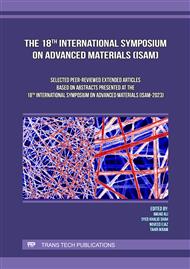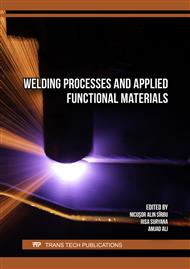[1]
Y. F. Zheng, X. N. Gu, and F. Witte, "Biodegradable metals," vol. 77, p.1–34, 2014.
DOI: 10.1016/j.mser.2014.01.001
Google Scholar
[2]
N. Eliaz, "Corrosion of metallic biomaterials: A review," Materials (Basel)., vol. 12, no. 3, 2019.
DOI: 10.3390/ma12030407
Google Scholar
[3]
K. Prasad et al., "Metallic biomaterials: Current challenges and opportunities," Materials, vol. 10, no. 8. 2017.
DOI: 10.3390/ma10080884
Google Scholar
[4]
G. Gąsior, J. Szczepański, and A. Radtke, "Biodegradable Iron-Based Materials—What Was Done and What More Can Be Done?," Materials (Basel)., vol. 14, no. 12, p.3381, Jun. (2021)
DOI: 10.3390/ma14123381
Google Scholar
[5]
J. Hufenbach et al., "S and B microalloying of biodegradable Fe-30Mn-1C - Effects on microstructure, tensile properties, in vitro degradation and cytotoxicity," Mater. Des., vol. 142, p.22–35, 2018.
DOI: 10.1016/j.matdes.2018.01.005
Google Scholar
[6]
S. Mandal, R. Ummadi, M. Bose, V. K. Balla, and M. Roy, "Fe–Mn–Cu alloy as biodegradable material with enhanced antimicrobial properties," Mater. Lett., vol. 237, p.323–327, 2019.
DOI: 10.1016/j.matlet.2018.11.117
Google Scholar
[7]
T. Huang, J. Cheng, and Y. F. Zheng, "In vitro degradation and biocompatibility of Fe – Pd and Fe – Pt composites fabricated by spark plasma sintering," Mater. Sci. Eng. C, vol. 35, p.43–53, 2014.
DOI: 10.1016/j.msec.2013.10.023
Google Scholar
[8]
H. Dong, F. Lin, A. R. Boccaccini, and S. Virtanen, "Corrosion behavior of biodegradable metals in two different simulated physiological solutions : Comparison of Mg , Zn and Fe," Corros. Sci., vol. 182, no. January, p.109278, 2021.
DOI: 10.1016/j.corsci.2021.109278
Google Scholar
[9]
N. Babacan et al., "Effect of silver additions on the microstructure, mechanical properties and corrosion behavior of biodegradable Fe-30Mn-6Si," Mater. Today Commun., vol. 28, no. July, p.102689, 2021.
DOI: 10.1016/j.mtcomm.2021.102689
Google Scholar
[10]
P. Goudarzi, M. Moazami-Goudarzi, and A. Masoudi, "Sintering, microstructure and properties of absorbable Fe–Mn-xCu alloys," Mater. Chem. Phys., vol. 287, no. March, p.126368, 2022.
DOI: 10.1016/j.matchemphys.2022.126368
Google Scholar
[11]
S. Wei, Z. Ma, L. Tan, J. Chen, R. D. K. Misra, and K. Yang, "Effect of copper content on the biodegradation behavior of Fe-Mn-C alloy system," Mater. Technol., vol. 37, no. 9, p.1109–1119, 2022.
DOI: 10.1080/10667857.2021.1922156
Google Scholar
[12]
Z. Ma, M. Gao, D. Na, Y. Li, L. Tan, and K. Yang, "Study on a biodegradable antibacterial Fe-Mn-C-Cu alloy as urinary implant material," Mater. Sci. Eng. C, vol. 103, no. April, 2019.
DOI: 10.1016/j.msec.2019.05.003
Google Scholar
[13]
S. Mandal, V. Kishore, M. Bose, S. K. Nandi, and M. Roy, "In vitro and in vivo degradability, biocompatibility and antimicrobial characteristics of Cu added iron-manganese alloy," J. Mater. Sci. Technol., vol. 84, p.159–172, 2021.
DOI: 10.1016/j.jmst.2020.12.029
Google Scholar
[14]
J. Fiocchi, J. N. Lemke, S. Zilio, C. A. Biffi, A. Coda, and A. Tuissi, "The effect of Si addition and thermomechanical processing in an Fe-Mn alloy for biodegradable implants: Mechanical performance and degradation behavior," Mater. Today Commun., vol. 27, no. February, p.102447, 2021.
DOI: 10.1016/j.mtcomm.2021.102447
Google Scholar
[15]
H. Khodaverdi, M. Mohri, E. Ghafoori, A. S. Ghorabaei, and M. Nili-Ahmadabadi, "Enhanced pseudoelasticity of an Fe-Mn-Si-based shape memory alloy by applying microstructural engineering through recrystallization and precipitation," J. Mater. Res. Technol., vol. 21, p.2999–3013, 2022.
DOI: 10.1016/j.jmrt.2022.10.092
Google Scholar
[16]
S. Prokoshkin et al., "Effect of Thermomechanical Treatment on Functional Properties of Biodegradable Fe-30Mn-5Si Shape Memory Alloy," Metall. Mater. Trans. A Phys. Metall. Mater. Sci., vol. 52, no. 5, p.2024–2032, 2021.
DOI: 10.1007/s11661-021-06217-5
Google Scholar
[17]
Y. A. Pustov, Y. S. Zhukova, and P. E. Malikova, "Structure and Corrosion-Electrochemical Behavior of Bioresorbable Alloys Based on the Fe – Mn System," vol. 54, no. 3, p.469–476, 2018.
DOI: 10.1134/s2070205118030139
Google Scholar



